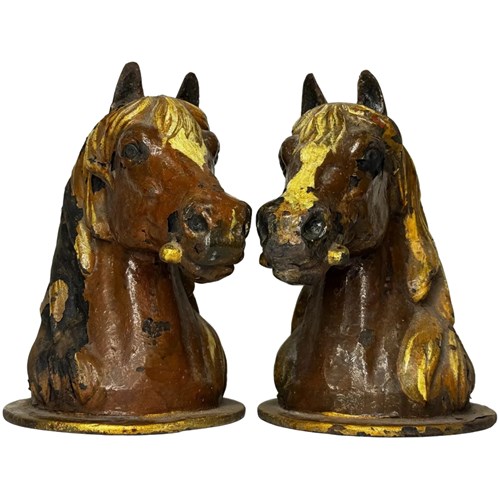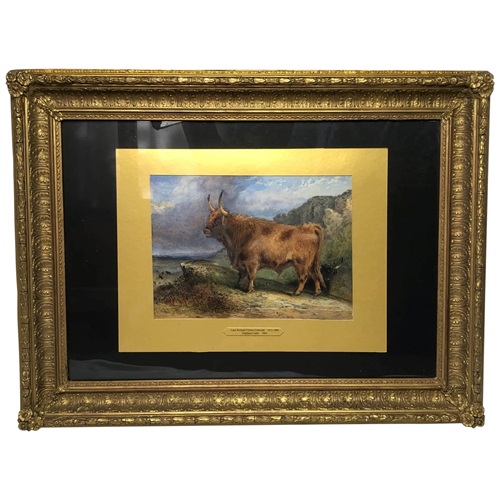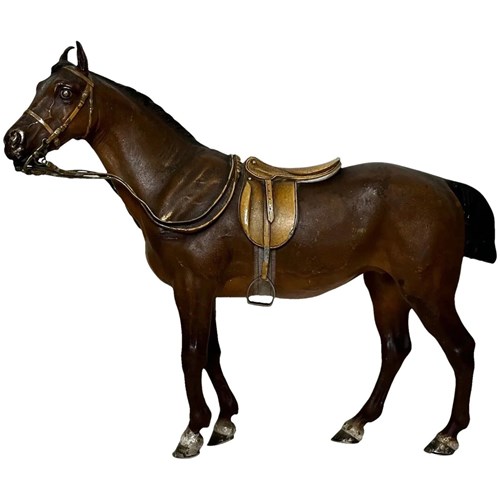Oil Portrait Of Duke Anthony Ulrich Of Brunswick-Lüneburg Order Of St Andrew
Stock No
CACL601
2023
- £14,500.00
- €16,449 Euro
- $18,953 US Dollar
Questions about this item?
Like this item?
Item Description
Circle of Georg Christoph Grooth (1703–1749), German School, c. 1740
Portrait of Duke Anthony Ulrich of Brunswick-Lüneburg, Generalissimo of Russia, wearing the sash of the Order of St Andrew and holding a field-marshal’s baton
Subject & Medium
A substantial mid-18th-century court portrait of Duke Anthony Ulrich of Brunswick-Lüneburg (1714–1774), shown half-length, turned three-quarter to the left, in full ceremonial and military dress with his Russian honours prominently displayed.
Oil on canvas, later relined, in a moulded and gilded wooden frame. The framed dimensions are approximately 97 × 78 × 4.5 cm, giving the picture impressive scale and presence. On stylistic grounds it is correctly described as Circle of Georg Christoph Grooth (1703–1749), German School, c. 1740–1750, aligning it with the German painters active for the Russian imperial court.
Composition & Technique
The composition is formal and uncluttered. Against a deep, neutral background, Anthony Ulrich stands out sharply, his powdered wig, pale flesh tones and richly coloured clothing drawing the eye. He wears a dark green coat lavishly embroidered with gold, over a crimson mantle lined with white ermine, signalling his princely Welf rank.
Across his chest runs the pale blue sash of the Imperial Order of St Andrew, the highest Russian chivalric order, with the dark blue collar of the order resting on his shoulders. On his breast is the radiating star of St Andrew, with the saltire clearly indicated in the centre. In his right hand he holds a dark field-marshal’s baton tipped with a jewelled finial, set diagonally so that it echoes the line of the sash and underlines his military authority.
The head and hands are carefully modelled over a relatively light ground, built up in thin, controlled layers to produce smooth, cool, porcelain-like flesh. The features are crisply drawn, with small highlights in the eyes and on the tip of the nose, and a faint flush to cheeks and lips that prevents the face from appearing stiff. The wig, lace and fur are treated more broadly and energetically, with broken strokes suggesting texture and sparkle rather than minute detail. A fine craquelure runs across the paint surface, consistent with age and adding to the painting’s period character.
Artist – Linked Stylistically
Although anonymous, the painting sits squarely within the mid-18th-century German–Russian court portrait tradition and can be convincingly linked to the stylistic circle of Georg Christoph Grooth (1703–1749).
Grooth’s portraits at the Russian court typically feature sober, dark backgrounds, cool and smoothly blended flesh, and a strong emphasis on insignia, sashes and batons as markers of rank. The present work shares all of these traits. The dignified but not overstated characterisation of the sitter, and the elegant balance between elaborate costume and calm expression, also show the influence of Antoine Pesne (1683–1757), whose Franco-German idiom shaped much north-German court portraiture.
In the absence of a signature or documentary tie to Grooth’s hand, a precise attribution would be speculative. The painting is therefore most responsibly catalogued as:
Circle of Georg Christoph Grooth (1703–1749), German School, c. 1740–1750.
This reflects both its quality and its close adherence to Grooth’s manner, without overstating the evidence.
About the Sitter
Anthony Ulrich of Brunswick-Lüneburg (Anton Ulrich, 1714–1774) was a member of the House of Welf, son of Ferdinand Albert II, Duke of Brunswick-Bevern. Like many younger princely sons, his fortunes were bound up with dynastic marriage. In 1739 he wed Anna Leopoldovna, granddaughter of Tsar Ivan V of Russia, bringing the Welf and Romanov houses into direct alliance.
When the infant Ivan VI, their son, was proclaimed emperor in 1740, Anna became regent and Anthony Ulrich was elevated to Generalissimo of the Russian Army, the highest military office in the empire. The Orders of St Andrew and the field-marshal’s baton shown here directly commemorate that brief period when a German prince effectively stood at the apex of Russian military command.
Historical Context
The political settlement that made this possible was short-lived. In 1741, Elizabeth, daughter of Peter the Great, seized the throne in a palace coup. Anthony Ulrich, Anna and their children were arrested, removed from the court and sent into confinement in northern Russia. Over the following decades they lived under close surveillance and severe restrictions, largely cut off from the outside world.
Anthony Ulrich’s health deteriorated; he eventually lost his sight and died a prisoner at Kholmogory in 1774. His children remained under various forms of guarded seclusion long after his death. Viewed from this perspective, the portrait records a “high-water mark”: a confident, ceremonial image of a generalissimo and prince at the very moment before his power and freedom were taken away. That knowledge lends the work a quiet but distinct poignancy.
Signed
The painting is unsigned; no signature or monogram appears on the front of the canvas, which is entirely typical for many court and studio portraits of the period.
On the reverse of the relined support, a later German inscription identifies the sitter as “Anton Ulrich, Prinz von Braunschweig-Wolfenbüttel” and summarises his life (birth in 1714, marriage to Anna, regent of Russia, appointment as generalissimo in 1740, imprisonment in 1741 and year of death). The handwriting and ink suggest a 20th-century date, so this functions as an instructive label rather than a contemporary note. Nonetheless, it is biographically accurate and supports the identification already evident from the sitter’s appearance and regalia.
Framed
The picture is presented in a later giltwood frame of moulded profile, chosen to suit the period and scale of the painting. The frame retains an attractive, warm gilded tone, with expected signs of age: light rubbing on raised edges, small chips at corners and some surface dust in the recesses. Structurally it is sound, with no obvious open joints, and it complements the painting well. The ensemble is ready to hang.
Provenance
The early ownership of the portrait has not yet been traced in detail, but the surviving evidence is consistent and points clearly to a German origin.
The sitter himself is a Brunswick-Welf prince; the inscription on the reverse is in German; and the style aligns with German-trained painters working for, or in connection with, the Russian imperial court. At some point – likely in the 19th or early 20th century – the painting underwent relining, and was mounted on its present stretcher. The verso inscription appears to date from this phase, probably added by a restorer, dealer or historically minded owner to preserve the identity of the sitter.
By the 21st century, the portrait was in the British art trade, handled by Cheshire Antiques Consultant Ltd., and offered as an 18th-century German School portrait of Duke Anthony Ulrich of Brunswick-Lüneburg. It has appeared under that description on various platforms and has since passed into the present collection.
Given the sitter, language and style, it is plausible – though as yet undocumented – that the painting originated either within the Brunswick-Welf circle or in close connection with the Russian court, and subsequently hung for many decades in a north-German noble or substantial bourgeois interior before entering the wider European and then British market.
Why You’ll Love It
This portrait brings together visual drama, historical depth and serious art-historical context.
Visually, it is a commanding decorative piece: the interplay of black ground, pale wig and flesh, emerald-green coat, crimson ermine mantle and pale blue sash is striking, and the star of the Order of St Andrew and the jewelled baton punctuate the composition with brilliant detail. The picture reads strongly across a room yet offers plenty of interest at close range.
Historically, the sitter is a genuine “story” figure: not an anonymous nobleman, but the father of a briefly reigning Russian emperor, raised to the highest military rank and then cast down to a long imprisonment. The painting naturally prompts conversation and rewards anyone interested in 18th-century European or Russian history.
Art-historically, the attribution to the circle of Georg Christoph Grooth, within the Pesne-influenced German/Russian court tradition, gives the work solid grounding. It offers all the flavour of mid-18th-century court portraiture – orders, sash, baton and princely bearing – without straying into speculative attribution, making it an intelligent acquisition for a collector of European portraiture or imperial history.
Condition & Shipping
The painting is in good, stable condition for an 18th-century work on canvas. The surface shows fine craquelure and some heavier age cracks in places, as expected for its date. There are small, scattered losses and areas of foxing, most visible on close inspection, which have been addressed with minor historic retouching.
A horizontal mark near the upper part of the composition corresponds to the line where the edge of a frame or stretcher pressed from behind over many years. Along this band there are associated flakes and small losses to the paint layer. The previous relining has stabilised the support overall, and there is no indication of active lifting under normal viewing conditions.
The gilt frame shows ordinary wear – light abrasions, small chips, some ingrained dust – but remains structurally secure and visually suitable. The picture may be hung and enjoyed immediately. A future owner might choose to commission a light professional clean and localised conservation to unify the varnish, refine old retouching and visually soften the stretcher mark; such work would be a refinement rather than a necessity.
Shipping
The work is well suited to professional packing and shipment, including international transport. It should be wrapped in protective materials, with particular attention to the frame corners and face, and packed within a rigid double-walled cardboard box. Transport via a reputable fine-art courier, with full insurance, tracking and proof of delivery, is strongly recommended.
As an 18th-century German School portrait in the circle of Grooth, the painting would not usually encounter complex export-licence issues, though buyers should confirm any applicable import or cultural-property regulations in their own jurisdiction.
Item Info
Seller Location
Covent Garden, London
Period
14500
Item Location
United Kingdom
Seller Location
Covent Garden, London
Item Location
United Kingdom
Seller Contact No
+44 (0)7494 763382
More from CHESHIRE ANTIQUES CONSULTANT LTD

















